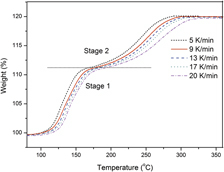Morphology of Ga/ZnO nanofibers after 1 hour at 600 °C. [Y. Shmueli, G.E. Shter, O. Assad, H. Haick, P. Sonntag, P. Ricoux, and G.S. Grader: Structural and electrical properties of single Ga/ZnO nanofibers synthesized by electrospinning. p. 1672.]
Articles
Evaporation-induced self-assembly of capillary cylindrical colloidal crystal in a face-centered cubic structure with controllable thickness
-
- Published online by Cambridge University Press:
- 14 May 2012, pp. 1663-1671
-
- Article
- Export citation
Structural and electrical properties of single Ga/ZnO nanofibers synthesized by electrospinning
-
- Published online by Cambridge University Press:
- 17 May 2012, pp. 1672-1679
-
- Article
- Export citation
Syntheses and characterizations of multiwalled carbon nanotubes-supported palladium nanocomposites
-
- Published online by Cambridge University Press:
- 14 May 2012, pp. 1680-1687
-
- Article
- Export citation
Platinum nanoparticle-functionalized tin dioxide nanowires via radiolysis and their sensing capability
-
- Published online by Cambridge University Press:
- 24 May 2012, pp. 1688-1694
-
- Article
- Export citation
Effect of radio frequency sputtering power on W–TiO2 nanotubes to improve photoelectrochemical performance
-
- Published online by Cambridge University Press:
- 25 May 2012, pp. 1695-1704
-
- Article
- Export citation
Superhard transition metal tetranitrides: XN4 (X = Re, Os, W)
-
- Published online by Cambridge University Press:
- 30 May 2012, pp. 1705-1715
-
- Article
- Export citation
Phase transformations in nanocomposite ZrAlN thin films during annealing
-
- Published online by Cambridge University Press:
- 30 May 2012, pp. 1716-1724
-
- Article
- Export citation
Investigation of the crystal structure on the nanomechanical properties of pulsed laser deposited niobium nitride thin films
-
- Published online by Cambridge University Press:
- 30 May 2012, pp. 1725-1731
-
- Article
- Export citation
Numerical analysis of different methods to calculate residual stresses in thin films based on instrumented indentation data
-
- Published online by Cambridge University Press:
- 01 June 2012, pp. 1732-1741
-
- Article
- Export citation
Effects of lattice defects on indentation-induced plasticity initiation behavior in metals
-
- Published online by Cambridge University Press:
- 30 May 2012, pp. 1742-1749
-
- Article
- Export citation
A novel two-step preparation of spinel LiMn2O4 nanowires and its electrochemical performance charaterization
-
- Published online by Cambridge University Press:
- 01 June 2012, pp. 1750-1754
-
- Article
- Export citation
Oxidation kinetics of copper nanowires synthesized by AC electrodeposition of copper into porous aluminum oxide templates
-
- Published online by Cambridge University Press:
- 01 June 2012, pp. 1755-1762
-
- Article
- Export citation
Interfacial defects distribution and strain coupling in the vertically aligned nanocomposite YBa2Cu3O7-X/ BaSnO3 thin films
-
- Published online by Cambridge University Press:
- 09 May 2012, pp. 1763-1769
-
- Article
- Export citation
Effects of PbO insert layer on the microstructure and energy storage performance of (042)-preferred PLZT antiferroelectric thick films
-
- Published online by Cambridge University Press:
- 09 May 2012, pp. 1770-1775
-
- Article
- Export citation
Front Cover (OFC, IFC) and matter
JMR volume 27 issue 13 Cover and Front matter
-
- Published online by Cambridge University Press:
- 15 June 2012, pp. f1-f4
-
- Article
-
- You have access
- Export citation
Back Cover (OBC, IBC) and matter
JMR volume 27 issue 13 Cover and Back matter
-
- Published online by Cambridge University Press:
- 15 June 2012, pp. b1-b2
-
- Article
-
- You have access
- Export citation















